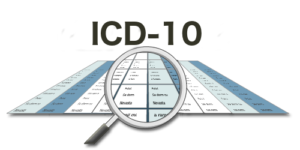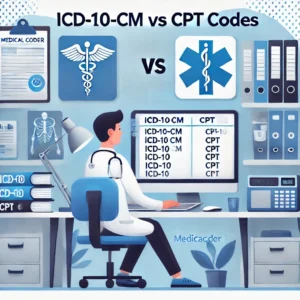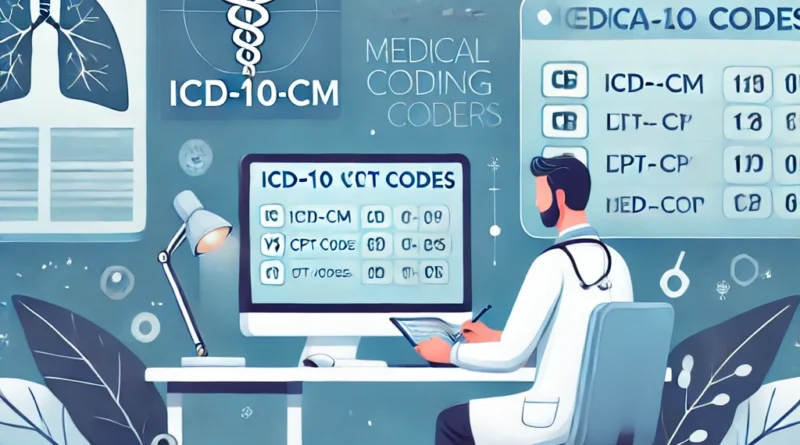ICD-10-CM vs CPT Codes – Key Differences Every US Medical Coder Should Know
ICD-10-CM vs CPT Codes: Medical coding is a crucial part of the healthcare system in the United States.
It ensures that medical diagnoses and procedures are accurately recorded and billed, facilitating proper reimbursement and data management.
Two of the most widely used coding systems in the US are ICD-10-CM and CPT codes.
While both coding systems are essential for medical documentation and billing, they serve different purposes and follow distinct guidelines.
Understanding the key differences between ICD-10-CM and CPT codes is critical for medical coders, healthcare providers, and billing specialists to ensure accurate coding, minimize claim denials, and maintain compliance with insurance requirements.
In this article, we’ll break down the differences between ICD-10-CM and CPT codes, their structures, and their uses in medical coding and billing.
Also Read: How to Start a Career in Medical Coding in the USA – A Step-by-Step Guide
✅ What is ICD-10-CM?

ICD-10-CM stands for International Classification of Diseases, 10th Revision, Clinical Modification. It is a system used to classify and code diagnoses in healthcare settings.
🔹 Purpose of ICD-10-CM:
- Used to record and track diseases and health conditions.
- Provides a standardized language for diagnosing diseases.
- Essential for statistical tracking and public health analysis.
- Used by healthcare providers, hospitals, and insurance companies for billing and reimbursement.
🔹 Structure of ICD-10-CM Codes:
- ICD-10-CM codes are alphanumeric and typically consist of 3 to 7 characters.
- The codes are divided into chapters based on the body system or disease category.
Example:
- J18.9 – Pneumonia, unspecified organism
- E11.65 – Type 2 diabetes mellitus with hyperglycemia
🔹 Who Uses ICD-10-CM Codes?
- Physicians
- Hospitals
- Insurance companies
- Public health agencies
ICD-10-CM codes are essential for documenting the reason for a patient’s visit and ensuring accurate billing for medical services.
✅ What is CPT?

CPT stands for Current Procedural Terminology. It is a system for coding medical procedures and services provided by healthcare professionals.
🔹 Purpose of CPT:
- Used to report medical, surgical, and diagnostic procedures.
- Provides a standardized coding system for healthcare providers and insurance companies.
- Ensures proper reimbursement for medical services.
- Used to track healthcare utilization and trends.
🔹 Structure of CPT Codes:
- CPT codes are numeric and consist of 5 digits.
- The codes are divided into three main categories:
| Category | Description |
|---|---|
| Category I | Procedures and services widely performed (e.g., surgery, radiology) |
| Category II | Performance measurement and quality reporting codes |
| Category III | Temporary codes for emerging technologies and procedures |
Example:
- 99213 – Office visit for an established patient (15 minutes)
- 77067 – Screening mammography, bilateral
🔹 Who Uses CPT Codes?
- Physicians
- Hospitals
- Insurance companies
- Outpatient facilities
CPT codes are primarily used to describe what was done during a medical visit or procedure, which helps in reimbursement and performance analysis.
📊 Key Differences Between ICD-10-CM vs CPT Codes
| Aspect | ICD-10-CM | CPT |
|---|---|---|
| Purpose | Describes the diagnosis or reason for the medical service | Describes the procedure or service performed |
| Code Format | Alphanumeric (3 to 7 characters) | Numeric (5 digits) |
| Example | E11.9 – Type 2 diabetes mellitus without complications | 99213 – Office visit for an established patient |
| Focus | WHY the patient received care | WHAT care was provided |
| Updating Authority | World Health Organization (WHO) & National Center for Health Statistics (NCHS) | American Medical Association (AMA) |
| Frequency of Updates | Annually | Annually |
| Application | Diagnostic coding | Procedural coding |
🔍 When to Use ICD-10-CM vs CPT Codes

A common question among new medical coders is when to use ICD-10-CM codes versus CPT codes. Here’s a simple guide to help:
✅ ICD-10-CM:
- Use ICD-10-CM codes to document the diagnosis or reason for a patient’s visit.
- Example: A patient with hypertension (I10).
✅ CPT:
- Use CPT codes to document the medical service or procedure performed during the visit.
- Example: A doctor performs a chest X-ray (71020).
Example Scenario:
- A patient visits a doctor for a cough and is diagnosis with acute bronchitis (J20.9).
- The doctor prescribes medication and performs a nebulizer treatment (94640).
- In this case:
- J20.9 – ICD-10-CM code for bronchitis (diagnosis)
- 94640 – CPT code for nebulizer treatment (procedure)
📌 Why Understanding ICD-10-CM vs CPT Codes Matters
Mastering the differences between ICD-10-CM and CPT codes is crucial for accurate billing and reimbursement. Mistakes in coding can lead to:
❌Rejected insurance claims
❌ Delayed payments
❌ Potential legal issues due to non-compliance
Knowing when and how to apply each code ensures smooth operations and maximizes the efficiency of the healthcare revenue cycle.
🚀 Tips for Accurately Using ICD-10-CM and CPT Codes
🔎 Stay Update: Both coding systems are updated annually — make sure you’re using the latest versions.
✅ Use Coding Resources: Rely on the official coding manuals from AAPC and AMA.
💡 Follow Documentation Guidelines: Ensure that physician notes and medical records are accurate and detailed.
📖 Take Continuing Education: Ongoing education helps you stay current with coding changes and compliance rules.
🏆 Conclusion
Understanding the differences between ICD-10-CM vs CPT Codes is essential for success in medical coding.
While ICD-10-CM codes are used for diagnosing and documenting diseases, CPT codes are for reporting medical procedures and services.
Both coding systems work together to ensure accurate billing, reimbursement, and patient care documentation.
If you’re pursuing a career in medical coding, mastering both ICD-10-CM and CPT codes will give you a competitive edge and open up more job opportunities in the healthcare industry.

